Maya Religion › Ehecatl » Ancient origins
Articles and Definitions › Contents
- Maya Religion › Ancient History
- Ehecatl › Who Was
Ancient civilizations › Historical and archaeological sites
Maya Religion › Ancient History
Definition and Origins
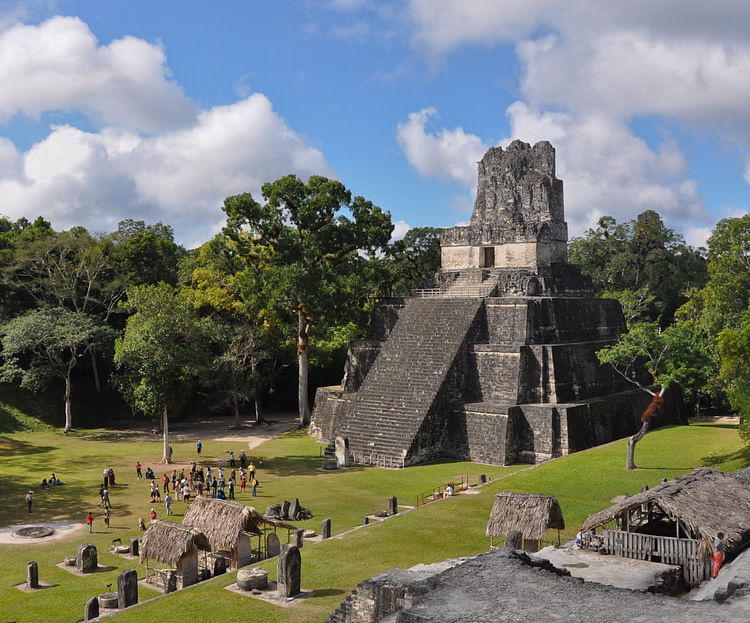
Maya religious beliefs are formed on the notion that virtually everything in the world contains k'uh, or sacredness. K'uh and k'uhul, similar terms which are used to explain the spirituality of all inanimate and animate things, describe the most divine life force of existence. Maya belief establishes the creation and sanctity of human beings, the earth, and all things sacred. This divine sanctity can be translated into Maya creation myths as well.
THE MAYA CREATION MYTH
Before explaining the Maya creation myths, it is important to understand the difference between the two sources that the Maya creation stories have been found in. These sources include the Popol Vuh and the Books of Chilam Balam. The Popol Vuh is associated with the highland Maya of what is today Guatemala. It contains text about human creation, prophecies, and traditional myths and histories. The Books of Chilam Balam are normally associated with the lowland Maya of the Yucatán area of Mexico. There are several books of Chilam Balam which are named for the area in which they were written. The most famous and influential books include the books of Chumayel, Tizimin, Mani, Kaua, Ixil, Tusik, and Codex Pérez. The books are written by a Jaguar priest, a literal translation for Chilam Balam. These books date to colonial Spanish times, circa 1500s CE, and there is a clear influence of Spanish colonialism on the creation stories of the Chilam Balam.
For the Maya the creation of the earth is said to have been a deed of Huracán, the wind and sky god. The sky and earth connected, which left no space for any beings or vegetation to grow. In order to make space, a Ceiba tree was planted. The tree grew roots in all the levels of the underworld and its branches grew into the upper world. The tree trunk grew to leave space on earth for animals, plants, and humans. According to Maya belief, animals and plants were extant before humans.The gods were not satisfied with only the animals because they could not speak to honor them. From there, humans were made in order to honor the gods.

The Lost Gods: The Maya (Planet Knowledge)
THE MANY EPOCHS OF THE MAYA
According to Maya texts, thus far, there have been three creations. Two of these creations have ended or, in other words, the creatures have been destroyed. There are many variations of the three creations. Some have been influenced by Christianity, however, the basic events of the creations are detailed in the following explanation from the Popol Vuh of the highland Maya.
Built from Mud
The first creation saw the people who were made of mud. The mud people were not the most productive as many were not able to think in the capacity that modern-day humans do and, according to Maya sacred texts, these men “spoke but had no mind.” They could not move because they were made of mud and they also were not technically mortal. The gods were not happy with their first creation, so they destroyed the mud people with water.
Built from Wood
For the second creation, the deities made men from wood and women from reeds. These people could function as humans do, but had no souls and did not honor the gods. They were also immortal. When they died, they only remained dead for three days and would rise from the dead. The destruction of the tree men and reed women was caused by an inundation of boiling hot water. The few who may have survived this apocalypse are thought to have become the monkeys that exist today.
Built from Maize
The third creation saw the birth of modern-day humans. These humans are made of white and yellow maize dough and the blood of the gods. The first humans were four men and four women. These men and women were deemed too wise by the gods. The Maya deities believed these intelligent humans were a threat to their authority and almost destroyed them as well.However, Heart of Heaven (also known as Huracán, but in the creation story he is the Heart of Heaven, Heart of Earth, or Heart of Sky) clouded their minds and eyes so that they would become less wise.
THE MOST IMPORTANT CONCEPT TO UNDERSTAND ABOUT MAYA RELIGIOUS BELIEF IS THAT TIME AND THE CREATION OF HUMANS ARE THOUGHT TO BE CYCLICAL.
The different Maya groups believe in a variety of creation myths. The most important concept to understand about Maya religious belief is that time and the creation of humans are thought to be cyclical. This means that some Maya believe that contemporary humans will be destroyed and another creation is imminent. However, this does not necessarily equate to the popularized notions that the Maya believed in an “end of the world” event. Belief in the end of humanity isn't the end of the world, it is the end of an era and, perhaps, the beginning of a new epoch of the gods.
The gods destroyed the different versions of “humans” because they either could not or would not worship their creators. This is a crucial consideration for the gods. They could not afford to have creations which were unworthy and incapable of providing sustenance to the gods.
MAJOR MAYA GODS & GODDESSES
Typically, Maya gods are fluid and have diverse personalities. This sometimes makes it difficult to distinguish one god from another. However, it may be simpler to keep in mind that although the Maya deities are numerous, the most consequential gods sometimes morph with the less notable gods and share characteristics of both deities. The incorporation of connectivity in Maya culture, not surprisingly, applies to Maya deities as well. Some deities even have conflicting personality traits.
The multiplicity of the deities' personalities are furthered by their appearance. Many gods are an amalgamation of a human and particular animal. They are also associated with different cardinal directions and an individual god's importance can vary depending on historical context. This fluidity is precisely why scholars refer to some Maya deities with the letters of the Latin alphabet.
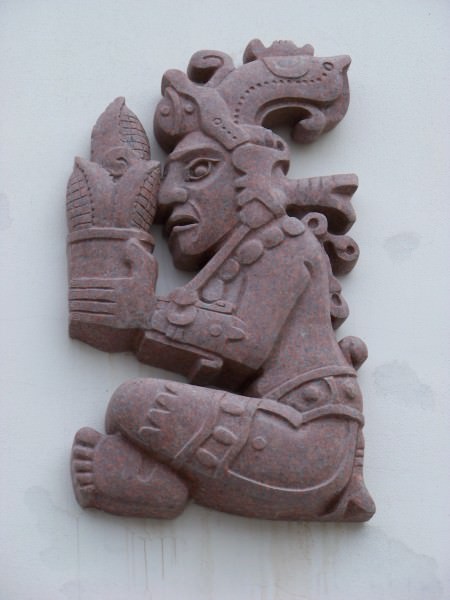
Yum Caax
Itzam Ná & Ix Chebel Yax
Itzam Ná is the god attributed to creation. Not much is known about him and the same can be said of his counterpart, Ix Chebel Yax. Itzam Ná is often depicted as a squinty-eyed, long-nosed old man or sometimes even an iguana. Ix Chebel Yax was the wife of Itzam Ná and is also depicted as an iguana. Both she and Itzam Ná are considered to be high in the hierarchy of gods. The spelling of their names can vary, as can the spellings of many Maya names can.
Huracán
Huracán, another significant Maya god, is often referred to as the Heart of Heaven, Heart of Sky, or Heart of Earth. While there is not much direct evidence about Huracán being the supreme creator god, the Popol Vuh does imply in one of its prayers that Huracán is a “giver of life.” The same prayer also refers to Huracán as the Heart of Heaven and Earth, which also suggests his importance as a creator. Due to the fluidity of Maya gods, it's not vital to make an absolutely clear distinction between the creator gods. Having said that, however, Huracán is typically associated with the Quiché Maya of Guatemala. The Quiché believe that Huracán formed the earth and created it for humans. He, too, formed people by making them out of maize dough and is lord of fire, storms, and wind.
K'inich Ajaw
K'inich Ajaw (pronounced Ah-how), sometimes known as God G or Kinich Ahau, is the “Sun-faced Lord.” K'inich Ajaw is typically portrayed as rising or being born in the East and aging as the sun sets. This fierce sun deity would then turn into a jaguar and become a war advisor in the underworld. The sun deities are both worshipped and feared because, while they offer the life-giving properties of the sun, they can sometimes provide too much sun and cause a drought.
Hun H'unahpu
The maize god, Hun H'unahpu, is perhaps the most important of the celestial beings as well. Also referred to as God E, Hun H'unahpu is considered to be the creator of modern humans by the lowland Yucatec Maya. This is because his maize and blood are what made humanity possible. He is a symbol of life and fertility and is portrayed as a young, long-haired man.
Chak
Chak, the seeming counterpart of K'inich Ajaw, is the rain god or God B. Chak is both part human and part reptile and he is usually shown with a lightning bolt, a serpent, or an axe. This fearsome god sometimes is shown painted in blue and with snake-like whiskers protruding from his face. The Maya believe that Chak lived in caves where he would make lightning, thunder, and clouds. Chak, too, was both feared and worshipped. He brought the needed rains for the people, but also produced floods, threatening lightning, and behaved much like a wild storm. He also demanded blood sacrifices in payment for the rains that he provided.
K'awil
God K, or K'awil, is the keeper of the scepter. He is predominantly the protector of the royal line and is known for being linked to lightning as well. He is usually pictured with a piercing of a smoking torch or a grisly axe blade. In addition to his frightful piercings, he also has a snake as one foot and an upturned snout for the other. K'awil is credited with discovering cocoa and maize after striking a mountain with one of his lightning bolts.
Kisim
Kisim, or God A, is known as the “flatulent one.” Don't let the humorous name fool you, though. This deity is a terrifying god of death and decay. Kisim has been portrayed as a veritable decomposing skeleton or zombie. Sometimes, Kisim was accompanied by an owl. In Maya belief, owls are messengers of the underworld.
Ix Chel
God O, or Ix Chel, is the goddess of rainbows. While rainbows may symbolize goodwill in western culture, Ix Chel should not be confused as a god of goodwill. The Maya actually believe that rainbows are the “flatulence of demons,” and bring bad luck and disease. Ix Chel also represents these things because of her association with rainbows. In her typical form, Ix Chel is a fanged, clawed, and dilapidated crone. However, in conjunction with the duplicity of Maya beings, Ix Chel also has a more benevolent form. She occasionally represents fertility and childbirth and, in these contexts, she is pictured as youthful and beautiful.
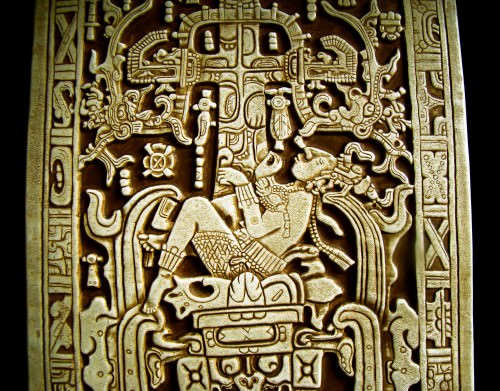 PAKAL THE GREAT & XIBALBA
PAKAL THE GREAT & XIBALBA

The Hero Twins
Finally, the legend of the Hero Twins entails the adventures of two brothers, Xbalanque and Hunahpu, through the underworld.The legend, chronicled in the Popol Vuh, begins with the conception of the brother-gods. The Twins' father was the god Hun H'unahpu. Hun H'unahpu and his brother were lured to the underworld to be sacrificed through decapitation. However, because Hun H'unahpu was immortal, his decapitated head survived and turned into a fruit on a tree. Hun H'unahpu's fruit head spit into the hand of the goddess Xquic, who ultimately gave birth to Xbalanque and Hunahpu, the Hero Twins.
The twins faced many challenges, but the most epic story is of their journey through Xibalba (pronounced Shee-bahl-bah), the Maya underworld.
The twins were summoned to the underworld after playing a raucous and loud ballgame above the heads of the lords of Xibalba. The lords challenged the twins many times, but through wit and cunning, the twins were able to best the lords of Xibalba. Xbalanque and Hunahpu grew tired of the endless challenges and devised a way to escape the underworld. They disguised themselves as travelers and entertained the underworld gods with tricks and games. The lords were so impressed with their trick of bringing a person back to life after they were sacrificed that they asked the twins to sacrifice them and bring them back to life. However, instead of bringing the gods back to life, the twins left them dead and made the underworld a place for the wretched. The Hero Twins and the lords of Xibalba now reside in the night sky as stars. Kings were thought to follow the trials of the Hero Twins after their death and make their journey to the heavens or upper world.
There are many more celestial beings, but the aforementioned are those which occur most frequently. They can come in many forms and their multiplicity is a pillar of the connective ideals of Maya religion.
HEAVEN, HELL, & THE CARDINAL DIRECTIONS
Contrary to contemporary western ideas of heaven and hell, the Maya believed in different levels of these realms. There are three main areas to distinguish from one another, however. The Maya understand supernatural levels not as heaven and hell, but as the upper world, middle world, and underworld.
The upper world consists of thirteen levels, the middle world is one level, and the underworld is nine levels. The Ceiba tree is believed to grow through all of the realms, from the highest level of the upper world to the lowest level of the underworld. The Ceiba tree is vital to understanding the importance of the cardinal directions in the Maya world.
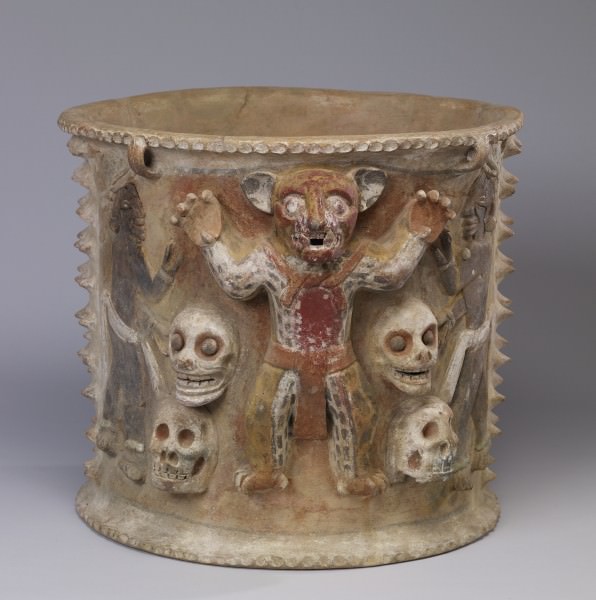
Maya Urn with Jaguar Figure & Skulls
Maya deities, in particular, are linked to the cardinal directions. While we are familiar with the four cardinal directions, the Maya understood that there were five elements to the cardinal directions, the four directions and the center. Arguably, the most meaningful cardinal direction to the Maya is the east. The east is where the sun rises and it is associated with birth because of the Maya belief that the sun is born daily from the east.
These principles were also part of Maya daily life. Homes were designed to reflect the cardinal directions and the Ceiba tree.The Maya even built hearths at the center of their homes in order to represent the Ceiba-tree center of the cardinal directions.
MAYA RITUALS
The Maya participated in various religious rituals. Not all of these were related to human sacrifice, although sacrifice was a common practice in religious ceremonies. Contrary to popular belief, ritual sacrifice was not restricted to the gruesome death of a poor captive. While this did happen in the Maya world on a few occasions, it was a relatively rare occurrence. By far the most common sacrifice ritual was bloodletting.
BY FAR THE MOST COMMON MAYA SACRIFICE RITUAL WAS BLOODLETTING.
Bloodletting
Bloodletting is precisely as it sounds, the spilling of blood as a practice of sacrifice. In the case of the Maya, bloodletting was constrained to the royal line. The gods demanded blood because of the initial creation where the gods spilled their blood in order to give life to humanity. Also, but not as often, bloodletting was performed in order to communicate with ancestors.
The practice of bloodletting marked significant dates in the Maya world. Royals participating in the practice would spend, sometimes, days performing purification rituals in order to prepare for bloodletting. Both men and women of royal lineages were expected to perform these rituals. Maya kings and queens would participate in varying forms of bloodletting, even making sacred tools to perform the ritual. Blood was usually taken from different parts of the body with specialized tools designed to produce more blood and perhaps more pain as well. The tools were typically made of stingray spines and adorned with different glyphs to show their religious significance. One frightful instance of sacrifice noted by Rubalcaba described how women, typically royal women, would use a thorned rope to pierce their tongue and draw blood to scatter over Maya icons.Men, on the other hand, would do the same, except on the penis rather than the tongue.
The practice of bloodletting would often serve to commemorate and sanctify important events such as births, ascents to the throne, and anniversaries. On the other hand, human sacrifice was reserved for the greatest Maya events.
Human Sacrifice
While wars were usually fought for reasons other than religion, when wars did occur, religion would become involved.Oftentimes, shamans or priests would help plan war strategies. A war priest was called a nacom. The Maya would often combine aspects of warfare and religion. Typically, this was in the form of taking prisoners for sacrifice.
Sacrifices were important in keeping the gods satisfied and were also vital in ensuring a military victory. When a king or queen would ascend to the throne and a political prisoner had been captured, they would commemorate the life-altering event with a human sacrifice. Typically, these prisoners would be royals or elites of an enemy state. The most high-up royals were saved for the sole purpose of recreating events from the Popol Vuh.
These sacrifices were performed in many ways, but there were three methods that were most common. The first method was through decapitation. The next method was the popularized method of removing the heart from the living person. The final, most popular, method was to throw a living person into a cenote, or natural well, as an offering to the gods.
 PRESENTATION OF CAPTIVES TO A MAYA RULER
PRESENTATION OF CAPTIVES TO A MAYA RULER

Other Offerings & Rituals
While the most prevalent ritual associated to the ancient Maya is the practice of sacrifice, they also performed other kinds of rituals. Not all Maya offerings were so bloody and gruesome. While they may not seem quite logical to westerners, the alternative offerings do provide interesting ways to communicate with and satisfy the deities.
One rather startling and overlooked means of communication with the gods involved lowering children into cenotes. Children were placed in the wells in order for them to speak to the god or gods. After a few hours of being in the well, the children would be retrieved so that the message from the deities could be heard. Of course, the Maya also participated in offering to the gods precious items such as jade, gold, masks, shells, carved human bone, and ceremonial or sacred tools.
Marriage was another religious ritual and a cause for celebration. Maya marriages were typically arranged marriages within the same social class. Age at the time of marriage varied, but experts speculate that the marriage age was related to population growth and decline. When the Maya population declined, youths would marry at a younger age. Couples would be matched at a very young age, sometimes even when they were infants.
Marriages were performed by priests at the bridal home. Priests would burn incense to bring a fortuitous marriage and then a feast or other type of celebration would ensue. If the marriage was not deemed successful by either husband or wife, the couple could “divorce.” There is no known ritual for divorce, but it is intriguing that divorce was, more or less, an acceptable action.
Dance is another overlooked ritual. Dance rituals were performed to communicate with the gods. The dances would feature lavish costumes which depicted the visages of divinities. Often the Maya would wear or include ornaments such as staffs, spears, rattles, scepters, and even live snakes as dance aids. The Maya believed that by dressing and acting as a god, they would be overtaken by the god's spirit and therefore would be able to communicate with him or her.
The ancient Maya maintained a complex religion. The multifaceted gods and rituals have even persisted in today's Maya culture, however syncretized they have become. Their ideologies of creation, sacrifice, sacredness, and multiplicity are key to understanding the Maya religion.
Ehecatl › Who Was
Definition and Origins
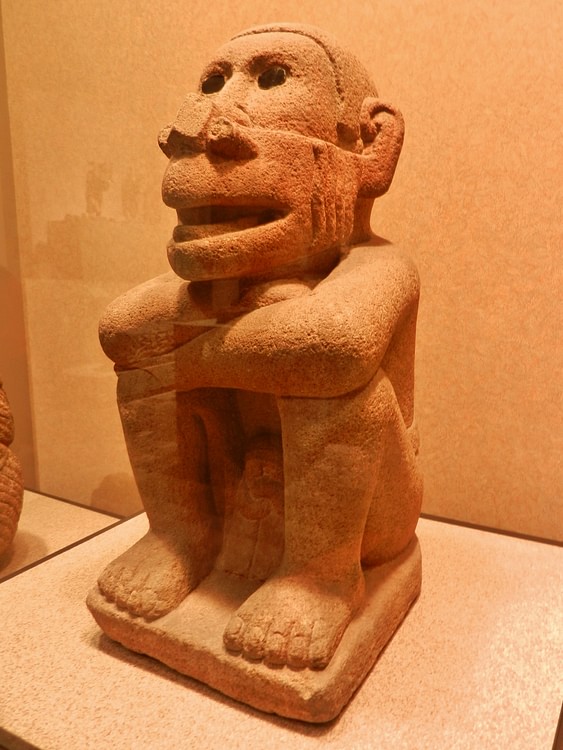
Ehecatl was a Mesoamerican god of air and winds, especially those which brought rains. Regarded as a manifestation of the great feathered serpent god Quetzalcoatl, he was sometimes known as Quetzalcoatl-Ehecatl, in which guise he helped create humanity in the Aztec creation myth and gave the gift of the maguey plant. He was also associated with the cardinal directions, colours, and several calendar dates.
NAME & ASSOCIATIONS
Ehecatl means 'wind' in nahuatl. Possibly of Huastec origin, who built many circular or curved temples in his honour, he was adopted by the Aztecs, who thought he was born from flint on the day 9 Wind, which was his other name. They also named the 2nd day in the Aztec calendar after him. Ehecatl acquired various associations besides the wind in general, amongst them the calendar dates 6 Ehecatl the sun, 7 Ehecatl the day humanity was created, and 9 Ehecatl the winds from the four quarters. He is the patron of the second trecena (a time period of the calendar) 1 Jaguar.
As the god was regarded as a manifestation or wind aspect of the feathered serpent god Quetzalcoatl, one of the most important deities in the Mesoamerican pantheon, he is sometimes referred to as Quetzalcoatl-Ehecatl. Thus, two more dates carry his name: 1 Ehecatl Iztac Tezcatlipoca ('White' Tezcatlipoca being the equivalent of Quetzalcoatl) and 4 Ehecatl Xolotl (Xolotl being Quetzalcoatl's twin). Quetzalcoatl-Ehecatl was also one of the four sky-bearing deities, specifically in the direction west. Ehecatl was regarded as the patron of merchants and was associated with spider monkeys, perhaps because of their great speed.
IN POSTCLASSIC SCULPTURE AND CODICES, EHECATL WEARS A CONICAL HAT AND DUCKBILL MASK.
CREATION MYTHOLOGY
Ehecatl features in the Aztec Creation mythology, first, as the 2nd sun of the cosmos Nahui Ehecatl, and then during the creation of the present world with the 5th and final sun. According to one version of the myth, Quetzalcoatl took on the guise of Ehecatl and descended into the Underworld where he stole the bones of the inhabitants of the former worlds in order to create humans in this one. Mictlantecuhtli, the god of the Underworld, was none too happy about people popping into his realm whenever they felt like it and so would only let Ehecatl go free if he could somehow get music from a conch shell. Ehecatl cleverly had worms bore holes in it and bees buzz inside it to produce a tremendous sound, thus ensuring his liberty.
Ehecatl also helped in the movement of the 5th sun and moon. These had been created when the twin brothers Nanahuatzin and Tecuciztecatl had thrown themselves into a sacrificial fire. The problem, though, was that neither celestial body could move and so Ehecatl, in one version at least, was called upon to blow them into their respective orbits.
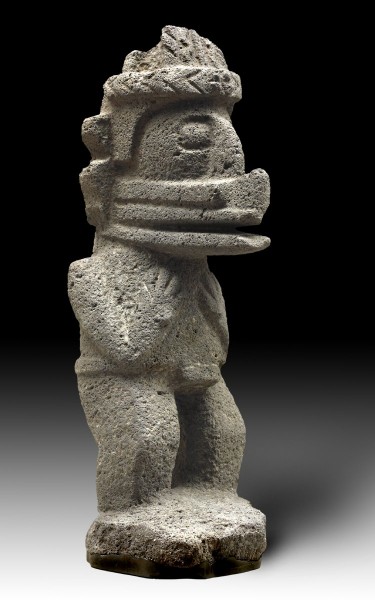
Ehecatl
EHECATL & MAYAHUEL
Ehecatl is sometimes credited with giving the important maguey plant ( Agave americana ) to humanity. This type of cactus was useful for its spines and its juice was fermented into the alcoholic drink pulque. The story begins with Ehecatl persuading Mayahuel, a beautiful young goddess, to descend from the heavens and become his lover. Down on earth, the two embraced as a pair of intertwining trees but their raptures were soon rudely interrupted by Tzitzmitl, the 'grandmother' goddess, who was Mayahuel's guardian. The elderly goddess split the tree in two and fed the pieces to her demon followers, the Tzitzimime.Ehecatl, being a more powerful god, was unharmed in this episode, and so he gathered what pieces of Mayahuel he could find and planted them in a field. These remains then grew into the maguey plant. Two other gifts to humanity besides pulque which are often credited to Ehecatl are music and maize.
TEMPLES
The Mesoamerican temples dedicated to Ehecatl and other wind gods are distinctive in that they are circular as opposed to the usual square pyramid, or they incorporate a curved end. The roof of such buildings was typically conical too. This design may reflect the desire to make them aerodynamically welcoming for the winds of the god they honour. The doorways are usually formed as the jaws of a giant snake. This may well be in imitation of the caves Mesoamerican peoples considered entrances to the Underworld where the winds were thought to originate from.
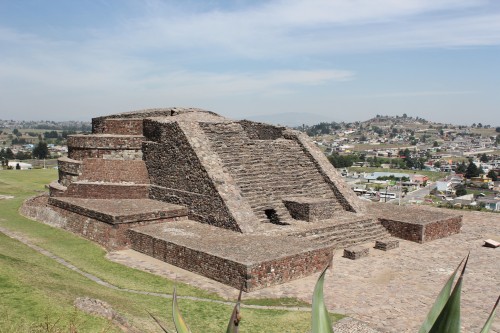
Temple of Ehecatl, Calixtlahuaca
REPRESENTATION IN ART
There are no known representations of the god prior to the 12th century CE, although two stelae from Maya Seibal, dating to the 9th century CE, depict a god with a beak-like face. Ehecatl is most frequently portrayed in Postclassic sculpture and codices, wearing a conical hat and duckbill mask or buccal (although sometimes the corners of the bill have fangs, a common feature of rain gods) which covers the lower part of his face. If coloured, then his body is painted black and his facemask red.He sometimes wears shells, especially the conch shell ( ehecacozcatl or 'wind jewel'), worn as a pectoral, with which he whistled his way out of the Underworld. Shells may be another clue as to the god's coastal Huastec origins. One of the most famous statues of the god is from a temple dedicated to Quetzalcoatl-Ehecatl at Calixtlahuaca in the Toluca Valley. The god stands 1.76 m tall, rigid and ready to blow his divine winds through his beak mask. It is now on display in the National Museum of Anthropology in Mexico City.
LICENSE:
Article based on information obtained from these sources:with permission from the Website Ancient History Encyclopedia
Content is available under License Creative Commons: Attribution-NonCommercial-ShareAlike 3.0 Unported. CC-BY-NC-SA License